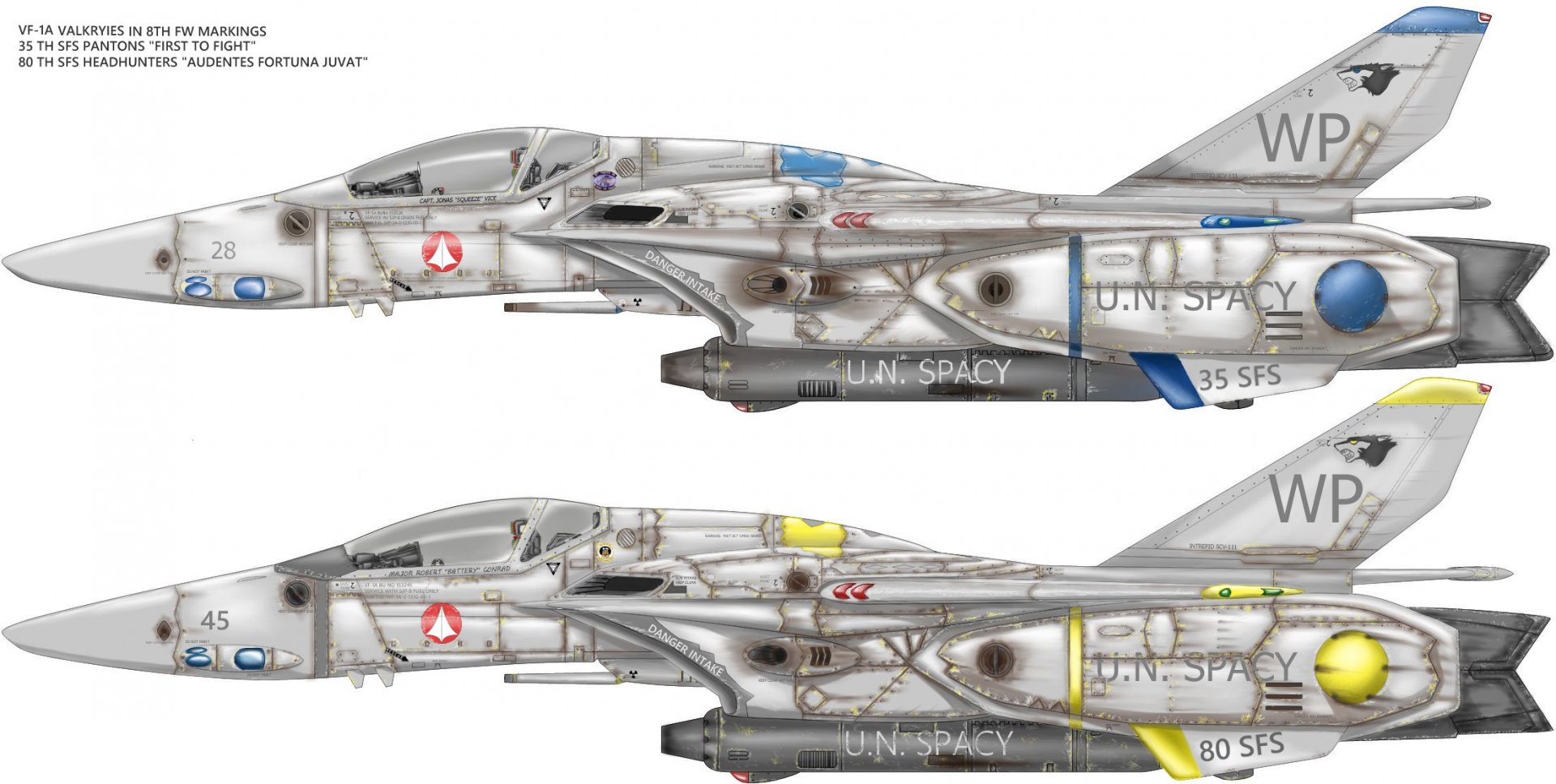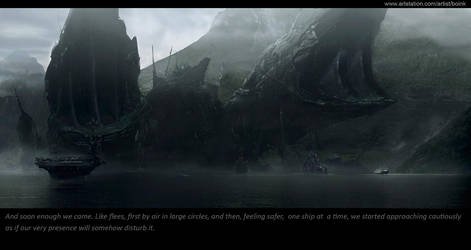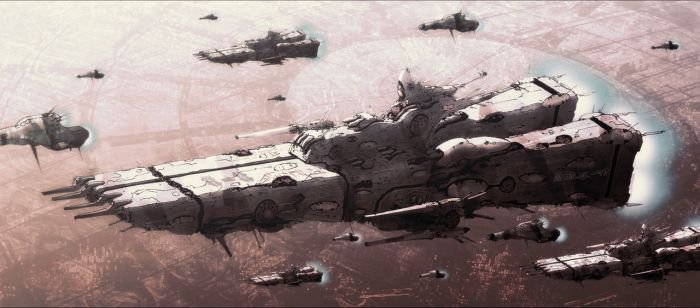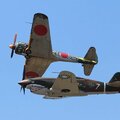-
Posts
478 -
Joined
-
Last visited
Content Type
Profiles
Forums
Events
Gallery
Everything posted by grigolosi
-

Aircraft Super Thread Mk.VII
grigolosi replied to David Hingtgen's topic in Anime or Science Fiction
The Newest Eagles are either equipped with the PW 229 or GE 129, depending on the contract and what the customer prefers. The USAF has kept its Eagles restricted to PW 220's and 229's. The 229 being in the 29-30k thrust rating. In a conversation I had with my pilot when I was stationed in Japan. He told me that when engaged at visual range by F-16's the Eagles would go completely DACM. They would try to run for altitude since the Eagle operates far better at higher altitudes than the Viper. These were the Charlie and Delta models he was referring too. I would say that the munitions dropped were SDB's most likely (GBU-53's) The newest version uses a tri seeker system for targeting giving the pilot more options in attacking their targets. It is also capable of carrying 8 of them internally. Not too sure about the targeting. I would ask some of the guys I know but that would be stepping into the realm of classified info more than likely. With the use of IDM systems in the aircraft now I would say it was target info passed from other aircraft to him. -
A tad bit late for this thread but here is some of Talos's Line art I colored in USAF 8th FW markings under UN Spacy control..........I did post these to his DA account for him to look at and his line art is very accurate. I added a few more details such as panel screws and fasteners. Thanks Talos for allowing us to color your line art!
-

Aircraft Super Thread Mk.VII
grigolosi replied to David Hingtgen's topic in Anime or Science Fiction
Very true Chronocidal, with the upgrade to the AESA radar alone in the Blk 60 F-16 two additional heat exchangers and a PAO system had to be installed on the frame to provide adequate cooling with the engine running . The heat output from the one on the right side is so much that getting into the right wheel well during summer operations is almost impossible. Plus anytime we performed maintenance with any electrical power running we had to use cooling air period, when runnig the radar you had to use the PAO cart also, The difference is that in the older F-16's you could run external power for up to 30 mins before requiring cooling air. -

Aircraft Super Thread Mk.VII
grigolosi replied to David Hingtgen's topic in Anime or Science Fiction
No the engine won't fit. The 135 is longer but slightly smaller in diameter than the GE which is the larger of the 2 engines currently used in the F-16. It would require re positioning a lot of the major connections between the engine and frame IE PLA shaft. ECS bleed air ducts, PTO shaft/gearbox placement and thrust pins. One thing to remember about the F-15 frame. The frame was built before any of its current systems went into it. They essentially crammed everything in after they proved the shape would fly. It would take some doing to re route hydraulics, wiring and bleed air systems. You would drop weight by replacing the flight controls with FBW and maybe be able to reduce the hydraulic systems to 2 and make them far simpler ( the hydro system on an Eagle is a nightmare to bleed, so much so that only the 7 level mechanics are qualified to do it). Also I AM NOT SOME DAMNED public relations salesman trying to sell a product for my employer. The info I have learned about the F-35 has come from other crew chiefs who I work with on a daily basis. and are not giving some stupid press conference to push a product. We spend our time like this discussing various aircraft. They have the actual knowledge of the aircraft first hand not from some damned media outlet. So I tend to believe them not some reporter who only see's what the USAF and LM allows them to see. -

Aircraft Super Thread Mk.VII
grigolosi replied to David Hingtgen's topic in Anime or Science Fiction
LOL....well the media would try to tell us that anyway F-ZeroOne. The energy recovery out of those maneuvers is damn good. I work with quite a few guys who came off the 35's. They told me that LM had to dumbdown some of the Avionics suite because it worked too well. Especially the camera's targeting system. They said it was able too zoom in too close......like the registration stickers on cars on the freeways. But that 135 is definitely putting out power. Now just imagine if they had gone with the GE engine instead........... -

Aircraft Super Thread Mk.VII
grigolosi replied to David Hingtgen's topic in Anime or Science Fiction
It does have adverse affects on the engine in tweaking its DEC or DEEC up to higher thrust ratings like that. The GE 132 is essentially an "uptweaked " GE 129. All the components on the engine are the same except one or two minor things. In the past few years they have run into issues with cracks forming between the aeration holes int he turbine blades due to the increase in both heat and pressure from the increased thrust. When I was stationed in Japan back in the 90's they had us trim up the DEC's on 2 of our Blk 50's to 31K and monitor them. The jets were restricted to local flying only because of it since the GE reps weren't sure what would actually happen to the engines. PW ran into issues with the burner cans on the early 229's. The flame holders were falling apart since they were the same design used in the 220. The Increase in thrust was tearing them apart. -
Yeah I found it. Good eye TehPW! It is from his book "Tenjin Hidetaka artworks of Macross, Valkyries". Hope this helps Ikaruss! http://gbmshop.blogspot.com/2018/01/valkyries-tenjin-hidetaka-art-works-of.html
- 2 replies
-
- vf-1s
- hikaru ichijo
-
(and 2 more)
Tagged with:
-
I have messaged with him on several occasions. He lives in the Philipines and works as a concept artist. He has an account on Deviantart if you want to see more of his work (https://www.deviantart.com/atomicgenjin). His Dimensional fortress drawings are incredible. Here is another one he created based on the Supervsion Army. This one is titled "Supervision Fleet, 996th Squadron, Trauzen group"
-
From the album: Untitled Album
-

Aircraft Super Thread Mk.VII
grigolosi replied to David Hingtgen's topic in Anime or Science Fiction
I know for a fact that the South Korean Strike eagles have GE's in them. But the Koreans have run into issues obtaining parts for them since the GE is the primary engine for the USAF F-16 fleet. The USAF essentially has top priority for the parts. At Edwards when i was stationed there they tested the GE 129 in some of the F-15's. The USAF F-15 crew chiefs hate them. They stated they are "too oil dependent". They are definitely more sensitive to correct oil servicing but not as bad they made them out to be. Yeah I have been away for quite a while. I am now working for a new employer (LM) in another overseas assignment........Anyway I know the information I saw said the F-15X was reported by non official sources. The USAF doe inquire at times about this stuff. I would bet whoever gave out this info saw some form of cost analysis somewhere on it. But only time will tell. -

Aircraft Super Thread Mk.VII
grigolosi replied to David Hingtgen's topic in Anime or Science Fiction
The F-35 isn't in the same size class as an F-16. The plane is huge compared to an F-16. I got to look at one up close back in 11' before I retired from AD. But in comparison yes it is supposed to take over the F-16's role in the AF. As I was looking at the picture of the new Russian toy. I noticed a couple of things. First of all no notching on the inboard edge next to the LEF's, F-22's have this to deter this sizable radar return surface ( I also noticed this on the Chinese monstrosity of a fighter). Second I noticed the Russians as in typical fashion only dog toothed certain panels, i.E. the landing gear doors. The rest of the surface has noticeable straight edge panel lines across the surface. If it has a negligible RCS I am curious as to how they did it without either coating the surface or panel lines with RAM or angling edges. Been away awhile, was changing employers. Also here is a video shot this week by the IQAF MOD and posted to their FB page. Showing a walk around and launch of one of their F-16 training missions....... -

Aircraft Super Thread Mk.VII
grigolosi replied to David Hingtgen's topic in Anime or Science Fiction
Nice video NZEOD. It looked like a local area fam flight. The visiting units at RF-Alaska would do the same on the first day of flying. Mainly to get the lay of the land and local area navigation landmarks for low level missions. Cruising through valley's like that is fun as hell. On my ride back in 93' my pilot took us through the local valley's in northern Japan and simulated bombing bridges that spanned the valleys. -

Aircraft Super Thread Mk.VII
grigolosi replied to David Hingtgen's topic in Anime or Science Fiction
Yeah the Charlie models were equipped with the 220's along with a lot of the A's. The Strike Eagles are currently using either 220's or 229's.. If I remember right the older Echoes are using the 220. Replacing the older boost systems would be a major job. The older cables and hydraulic components would have to come out and then the Flt control harnesses would have to be routed. Then a FLCS computer would also have to be installed. In the Eagles case it would also have to tie in with the vari-ramps. On another note since it is Veterans Day, Here is a video honoring the unsung folks who keep them flying...... https://www.dvidshub.net/video/492050/maintainers-driving-force -

Aircraft Super Thread Mk.VII
grigolosi replied to David Hingtgen's topic in Anime or Science Fiction
I know for the past 20 yrs most of us F-16 guy's have always asked why they haven't upgraded the Eagles to fly by wire systems. In actuality they could eliminate part of the hydraulic system by integating a fly by wire system. The newest ISA's (Integrated Servo Actuators) have their own self contained hydraulic reservoirs. The only other systems that would require hydraulics would be the landing gear, start system and gun. The ISA's also react faster than boost cable systems and would eliminate the issue the F-15's had with the flight control cable connection rods which cost the pilot at Spanghalem AB his life. Currently F-15's have 4 hydraulic systems. They could probably reduce that down to 2 maybe less with FBW systems. Hell the Koreans got smart and had their new Strike Eagles equipped with GE engines instead of PW's. I think its a good idea to finally upgrade that frame with newer systems and see how much teh frame can possibly improve. -

Aircraft Super Thread Mk.VII
grigolosi replied to David Hingtgen's topic in Anime or Science Fiction
I barely have patience for 1/72 scale, I can't imagine trying to detail out a 1/144 like that. I tried building that scale when I was in Japan in the 90's. Beside the small size our dog at the time ate the wheels on me ( I am not going to go into how that happened). I have mainly stuck with 1/48 with a few 1/72 thrown in from time to time. I own both the Hasegawa 1/72 VF-1 and VF-0B but still haven't had a chance to build them. Have a walk in closet shelf stacked with unbuilt kits. Looking forward to eventually getting some space to build again, once the oldest kid finally moves out. -

Aircraft Super Thread Mk.VII
grigolosi replied to David Hingtgen's topic in Anime or Science Fiction
No problem Mickyg. Yeah you are correct about that after landing. F-15's shutdown one engine as they are taxing in from the runways, it helps the ground crews who by EPA standards are supposed to catch the fuel dumped out of the engine scavenge drain. When P&W's shutdown the pilot or ground crew operating it are required to throttle up to 75% then position the throttle to off if for 7 seconds to scavenge the fuel out of the lines. Fuel still comes out but not as much as would normally come out when the engine isn't scavenged. GE's have a scanvenge pump on them that prevents having to do this. Most twin engine fighters have 3 or more hydro systems and each of them operates certain systems on the aircraft. Usually there is one primary that operates most of the essential systems: Flight controls, landing gear etc. So the pilots can shutdown the non essential engine prior to pulling into chocks. The newer PW's have the Secondary mode also. The older PW F-100PW200's had a BUC (Back Up Controller) that worked don the same principle but it was far more complex to do the check in chocks. The SEC Sceondary Mode check is simply done by placing the SEC switch to on and then running the engine up to 70%. The GE's have a problem that arises when in flight from time to time if the FLCC is getting bad air data information or if the DEC goes bad. We call it an Auto SEC transfer. This means the MEC (Mechanical Engine Control) takes over and closes the nozzle to prevent the pilot form selecting AB. The MEC controls all engine functions from Mil to Idle while the DEC handles functions in after burner. Also if the pilot of Crew Chief shuts the engine down and goes electrical power off before the engine drops below 55% RPM than the nozzle closes even if there is nothing wrong. GE's also develop a minor problem sometimes that causes the nozzle to close down of shutdown regardless of RPM to electrical power shutdown. It is caused by a minor disagreement between the engine hydraulic and electrical system caused by the RPM's dropping on shutdown and the engine hydro (fuel) system pressure dropping as it normally does. It is not a safety of flight issue so the engines are left alone until they are removed for either maintenance or time change. What is funny is that the FFP (Fuel Flow Proportioner) gauge in the cockpit on the GE doesn't have a set consumption rate. It literally just jumps around. So according to the book the only reading you should get is the numbers changing. -

Aircraft Super Thread Mk.VII
grigolosi replied to David Hingtgen's topic in Anime or Science Fiction
The engine nozzles open to 100% when the engine is at Idle. When the pilot throttles up the nozzles close down to help increase the thrust, it essentially works like a nozzle on a garden hose until the pilot goes to AB. The nozzle then opens to 100% to keep from blowing the augmenter off the aircraft. The nozzle will be open to 100% on engine shutdown. The upgraded F-14D's and later all F-14's in service were equipped with the F-100GE110-400 engines. They were essentially the same engine mounted in the F-16 except they were bigger in diameter. The turkey feathers are titanium and usually a light bronze in color but appear to silver'ish in sunlight. I have never heard of any twin engine fighter shutting down one of the engines for landing except in the case of an engine IFEs and as notoriously finicky as the old TF-30's were I would've wanted both engines running. -

Aircraft Super Thread Mk.VII
grigolosi replied to David Hingtgen's topic in Anime or Science Fiction
You are very correct Miles. I see them takeoff from here quite a bit. They get off the ground quick but they take a bit of time getting to their "cruising" altitude. I never worked them but they were included in our AF Career Development Course study books. These basically explain the systems of the different aircraft that fall under our AFSC. They have several features that have to be checked prior to take off at the end of runway, especially some of the flight controls. Hard to say what happened until the USAF releases the findings. I am curious as to what happened if both crewmen did manage to eject. -

Macross Δ (Delta) Mecha/Technology Thread - READ 1st POST
grigolosi replied to azrael's topic in Movies and TV Series
Ok now you have stepped into my realm. There are big differences in performance between the PW and GE powered F-16's. The engines may be listed in the same class but the GE has far better performance. GE F-16's are faster for one. The F-100-GE-100 series require more air flow hence the largemouth intake. The fanblades on a GE are far larger than on the PW and force more air into the compressor. They are also quicker and smoother in response to throttle inputs. The transition from military power to augmentor is smooth in a GE but in a PW you can actually feel the engine actually go into burner. It literally shakes the jet. (I have run both types on the ground if you are wondering how I know). Even the small mouth GE engined block 30's cannot keep up with the large mouth versions. The fanblades on a GE are far larger than on the PW and force more air into the compressor The pilots also prefer GE's due to the responsiveness of the engine compared to the PW. The entire diameter of the PW is also far smaller compared to a GE. PW's also use bleed air from the engine to run the exhaust nozzle and VSV's. The GE uses the aircraft's fuel and oil system making the anti icing system on the engine far less complex. There are systems mounted on engines of similar classes but performance can increased to distinguishing levels by changes to components, fan casing and inlet size and blade size. If you notice a large majority of F-16's used by foreign countries are PW powered birds. The PW is a more robust engine and simpler to maintain but its performance is lower than the GE. This is one of the reasons why the USAF uses them only on a few bases ( Nellis, Edwards, Eglin and Holloman, all of these are training or test wings). The Air National Guard operates only a few squadrons of PW powered birds but the majority of their units are GE's. Even if the YF-30 and 31 have a similar frame design Seto is correct. The slight differences in frame shape, center of gravity, stress points in the frame will cause changes to the frame and engine performance. It could be something as simple as frame vibrations caused by the engine when its running that influences the trimming or tuning/detuning of the engine. There is good possibility the inlet airflow levels may have changed between the two. Unless you put both frames in a wind tunnel though it is hard to tell. Certain grade fuels can cause changes in the settings on the engines, GE's can be switched by way of an allen stock key to run on other fuels besides JP-8. It changes the DEC/FADEC to the parameters set for those fuels. I am not sure what grades they use in Macross but I imagine there are several different depending on quality. -

Macross Δ (Delta) Mecha/Technology Thread - READ 1st POST
grigolosi replied to azrael's topic in Movies and TV Series
Aires in no way was I implying your English. The term tuned has been used repeatedly in macross itself. Primarily because the producers of course don't have first hand knowledge. I wasn't aiming it at you or anyone in general. I was just trying to correct a long term miss use of the term. The older engines actually have nechanical controls also that are adjusted simply through turns made with a small Allen stock key. -

Macross Δ (Delta) Mecha/Technology Thread - READ 1st POST
grigolosi replied to azrael's topic in Movies and TV Series
I don't want to sound rude or anything but this is driving me nuts as a an aircraft mechanic. Jet engines are trimmed not tuned. The engine performance is controlled by an engine computer. It most cases the computer is set at certain thrust settings but can be trimmed up or down if required to provide more thrust (usually at the engineers blessing and usually for testing purposes normally.) Anyway carry on with the thread..... -

Macross Δ (Delta) Mecha/Technology Thread - READ 1st POST
grigolosi replied to azrael's topic in Movies and TV Series
The vapor trails you see are generally created at low altitudes and when there is higher humidity in the air. So wingtip trails can form at subsonic speeds also. But almost all sonic vapor cones around the frame form only at the barrier. That is why 99% of the photos you see of these are all barrier breaks at low altitude and in humid dense air. Also the engine designs include Variable Stator Vanes in front of the fan section. While a variramp or shock cone reduces the inlet airflow to subsonic speeds the use of VSV's to angle the airflow directly into the engine also continues to reduce the airflow speed. This has for the most part eliminated compression stalls in the newer engines. The current GE's are damn near impossible to compressor stall. I have only seen one occasion for this to happen and it was pilot induced during ACM . The GE engineers actually had to see the engine data minute by minute to see the compressor stall happen. -

Macross Δ (Delta) - Mission 22 - READ 1st POST
grigolosi replied to azrael's topic in Movies and TV Series
Even sanctioned factory mods are performed in the field. In most cases a mod will not be performed without the manufacturers engineering input. So even if it may look jury rigged it more than likely was given an engineers blessing prior. As with any weapon system. These systems are constantly evolving and improving and a majority of the systems mods will or have been performed in the field.
























